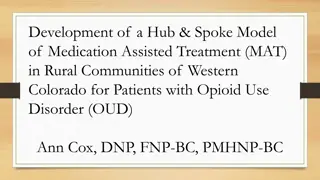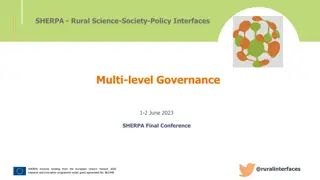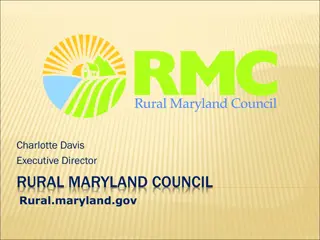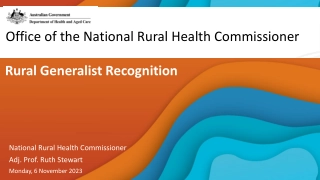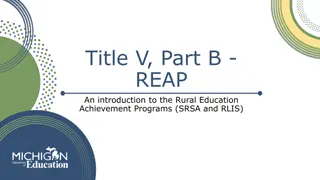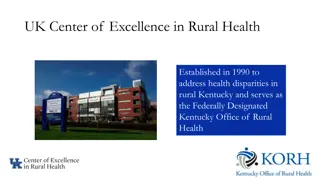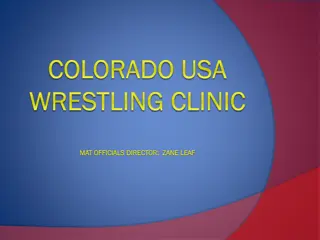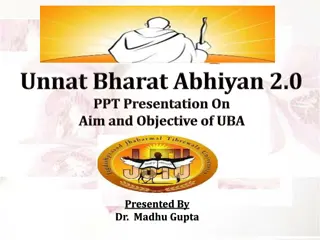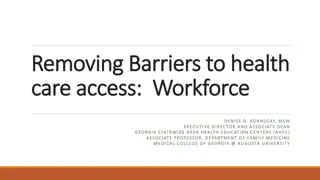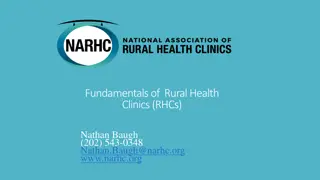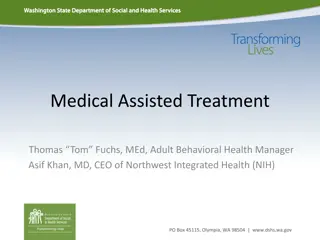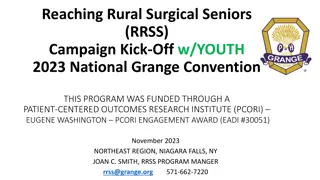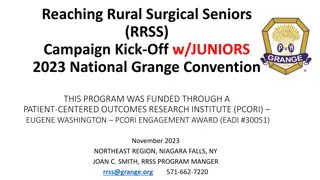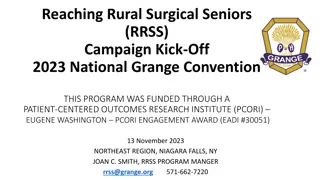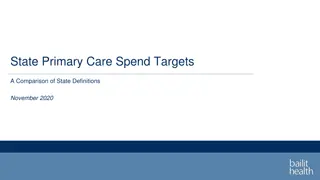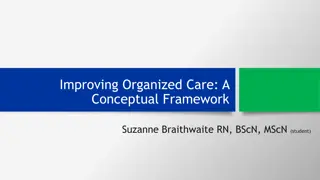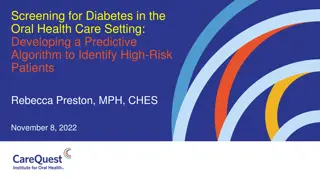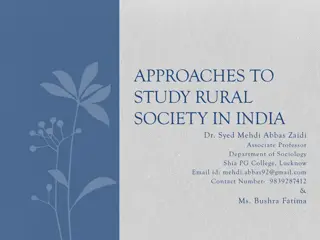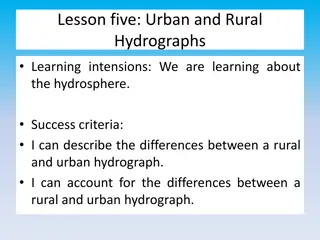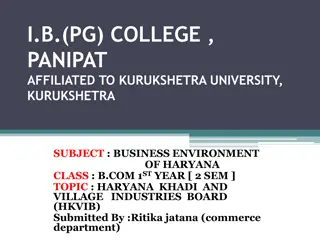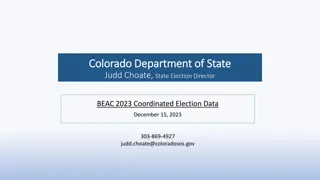Strategies for Enhancing MAT Provision in Rural Colorado Primary Care
The research explores methods to increase Medication Assisted Treatment (MAT) provision in primary care settings in rural Colorado. Despite the effectiveness of MAT in reducing opioid-related issues, there is limited adoption, particularly in rural areas. The IT MATTTRs project aims to address this gap through practice coaching, tele-training, and free MAT waiver training for providers. Baseline data collection and analysis provide valuable insights for enhancing MAT services in rural communities.
Download Presentation

Please find below an Image/Link to download the presentation.
The content on the website is provided AS IS for your information and personal use only. It may not be sold, licensed, or shared on other websites without obtaining consent from the author. Download presentation by click this link. If you encounter any issues during the download, it is possible that the publisher has removed the file from their server.
E N D
Presentation Transcript
Issues and Opportunities for Reducing Opioid Use in Rural Colorado Primary Care JODI HOLTROP, PHD KRISTEN CURCIJA, MPH BEKA MULLEN, MD MPH
Background More than 2.5 million people in the US suffer from Opioid Use Disorder (OUD) Medication assisted treatment (MAT) is known to reduce opioid-related mortality, opioid cravings, and risk of relapse Despite these evidence-based treatment approaches, there is limited adoption in clinical practice Only 20% of those with OUD receive appropriate treatment Rural areas are disproportionately affected More than of all rural counties lack a prescribing MAT provider
IT MATTTRS Project The Implementing Technology, Medication Assisted Treatment, and Team Training in Rural Colorado (IT MATTTRs) study aimed to increase provision of MAT in rural Colorado primary care Tested two different methods of practice training and assistance: practice coaching and tele- training Included access to free MAT waiver training for providers Prior to intervention, the project team conducted an evaluation of current practices and perceptions of opioid use and treatment IT MATTTRs 24-county study region
Methods Data Collection - July 2017 to September 2018 Baseline interviews with community health care settings in rural Colorado (2-4 interviewees per practice) Eastern plains and San Luis Valley Included a variety of clinical roles, such as providers, practice managers, and medical assistants Practice observations were performed (tours + field notes) Data Analysis September 2018 to August 2019 Grounded hermeneutic editing approach
Baseline Key Informant Demographic Data N = 108 % # Results: Interview Participants Gender Male Female Age Age 18-35 Age 36-64 Age 65+ Missing Race White Black / African American Asian American Indian/Alaska Native Native Hawaiian or Other Pacific Islander Other Missing Hispanic or Latino Yes No Practice Role Provider Clinical Staff (RN, LPN, MA) Administrative Staff (manager, front office, med records) Missing 18 90 17% 83% 29 73 27% 68% 5% 1% 5 1 108 total interviews conducted across 42 practice sites 92 85% 2% 1% 2% 0% 14% 0% Most interviewees were female (83%) and white (85%) 2 1 2 0 Variety of clinical roles 15 1/3 were providers, care team members, and administrators 0 38 70 35% 65% 38 34 42 35% 31% 39% 1 1%
Policies and procedures to reduce opioid use were widely available Most clinics used a variety of procedures including these core components: 1) PDMP prior to providing new prescriptions or refills 2) The use of a pain contract which would often outline details such as: No early refills Reasons for possible prescription cessation, including diversion or illicit drug use 3) Routine drug testing Notable clinician variability in the use of policies Despite written contracts or clinic policies, there was variability in how often providers (even at the same practice) would check PDMP or urine drug screens
The emotional toll of opioid prescribing Consistent message about the difficulty in prescribing opioids The emotional toll makes this experience of patient care distinct from other types of chronic conditions The experience feels adversarial, frightening, and sad Felt at all staff levels Providers feel duped when patients divert Front desk staff deal with disgruntled patients Particular concern in rural areas where there are strong social ties Stories of unhappy patients waiting outside for clinicians, clinic staff obtaining permits to carry guns I don t want anybody to be miserable or to suffer, but I also don t want to be part of this black-market loop that s goin on.
Lack of local resources for chronic pain and OUD treatment Have you ever tried to get authorization for a Medicaid patient on getting an MRI done for chronic back pain? Have you ever tried? And the hassles you have to go through and the time you spend on the phone, and the hassles it is? I mean it s just insane. Ideal resources to treat chronic pain are lacking This is particularly true in rural areas Includes PT, massage, chiropractor, acupuncture Few behavioral health options, addiction specialists Only a handful of chronic pain clinics and many don t have reputation of being helpful Virtually no OUD treatment access in these areas 2 total MAT providers in the counties represented in this project Patients are required to drive substantial distances Further, many patients with Medicaid are unable to get in
Desire to help, but hesitancy to engage with MAT There was a collective concern about the use of MAT and the resultant flood of opioid use patients Despite the fact that there is a prescribing limit on the DEA waiver Also concern about suboxone diversion Overall, generally low knowledge about and experience with MAT, although some excited to get started; knowledge helps There s concern if I raise my hand everybody gonna come flooding at me, I don t want my practice to be this.
Issues pertinent in rural communities Profit motive to sell opioids Economic opportunities are provided with diversion Worsened by heroine abuse in these areas Over-prescribing opioids City providers recognize the transportation/access difficulties experienced by patients and prescribe very high pill numbers
Conclusion Rural communities are impacted by the opioid epidemic and have found some solutions, like widespread adoption of clinical policies However, providers variably enact these policies There is both some excitement and willingness to try and also some hesitancy to engage with MAT Probably due to low knowledge about and experience with MAT Also likely heightened by the emotional toll from caring for OUD patients Resources are needed to better care for chronic pain and OUD
Discussion Our findings illustrate the unique experience of rural practices experience when caring for OUD patients These results can be used strategically to help practices treat OUD These phenomenon of MAT hesitancy calls for direct solutions to increase adoption: Start with only a few patients Find a mentor to emulate their MAT practice Establish patient boundaries Training programs need to be particularly sensitive to the emotional burden of OUD care
Questions? A big thank you to Linda Zittleman Jack Westfall All the ITM practices! Contact me: Jodi Holtrop, PhD JODI.HOLTROP@CUANSCHUTZ.EDU



